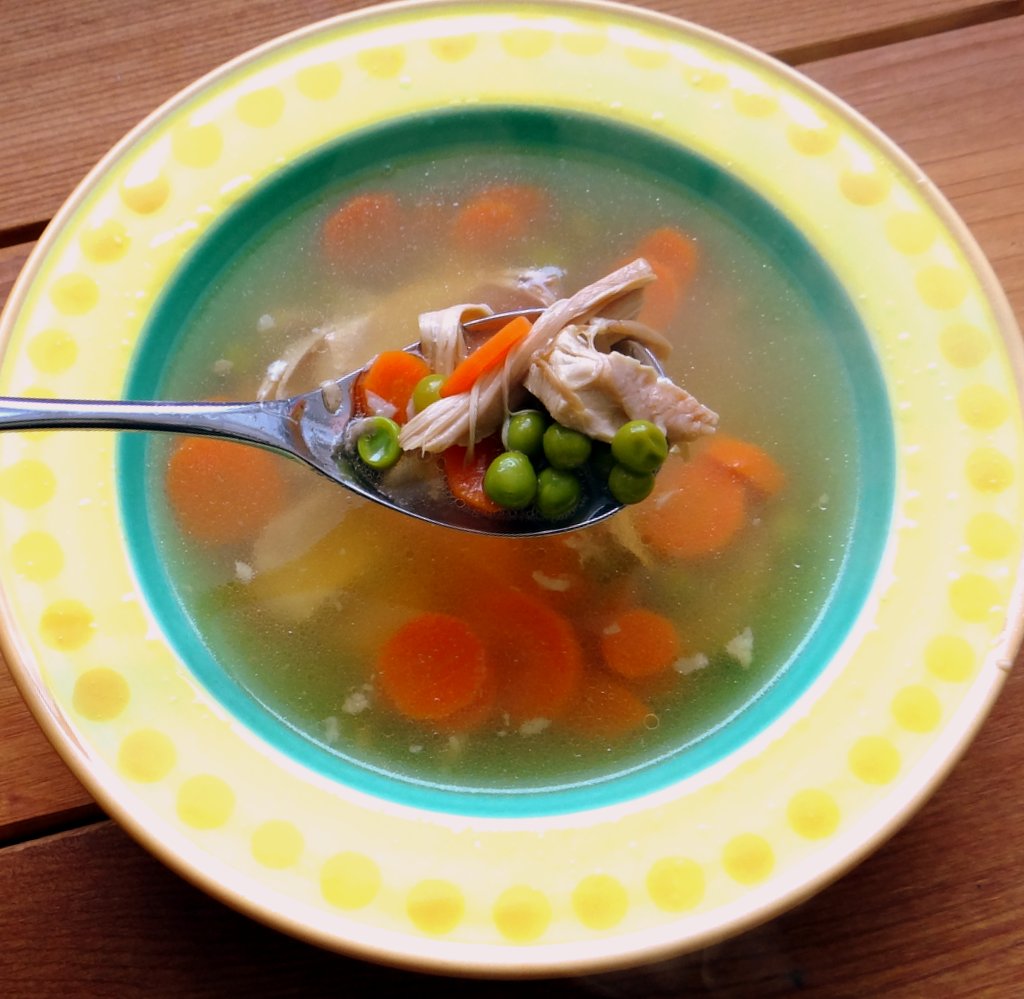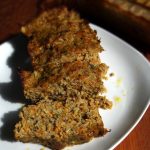
“I live on good soup, not on fine words.”
~ Moliere
An Ancestral Healing Food
When I was a little girl and would catch a cold, in addition to the Vicks Vapor Rub my mother massaged into my chest at night, she would also heat up a can of Campbell’s Chicken Noodle Soup to feed me during the day. I loved the warm, clear broth, bland aside from the taste of salt (perfect for my picky palate). The soup didn’t heal me, filled as it was with additives and MSG, but my mother’s love certainly helped. Homemade soup has been used for healing by cultures around the world for thousands of years. Without knowing it at the time, when I savored that canned soup as a child, my ancestral memory was reaching out for the real thing.
As an adult, I made real chicken soup for the first time, when my mother-in-law was recovering from pneumonia. I remember it so well: searching her grocery store for the solitary organic chicken tucked amid the conventional ones; scouring the produce department for its handful of organic vegetables; putting them all in her largest pot and letting it cook all day, until the meat fell off the bones and the vegetables gave their flavor to the stock. I remember the smell drew her from her room, where she had been napping all day, and how the color seemed to return to her cheeks as she ate. She stayed up visiting for hours that night, before returning to bed and waking up considerably better the next day. This is the soup that’s lovingly called Jewish Penicillin, for good reason.
However, you don’t have to wait until you’re sick to eat this soup. In fact, for the past 6 months I’ve been eating this for breakfast. I started the Paleo Autoimmune Protocol in January, which doesn’t allow grains, eggs or dairy. As an American, this can leave you wondering what on earth to eat, but did you know that millions of people around the world start their day with soup? And how smart they are! What’s a more nurturing, soothing and healing way to start the day? For people with autoimmune disease, homemade broths are recommended as an essential healing food. This recipe involves slow cooking of the whole chicken, releasing beneficial gelatin and amino acids, making bone broth a natural component of the meal. The soup also contains other healing foods such as onion, garlic, ginger and coconut oil. The result is a delicious and nutritious soup that I never tire of eating. I also notice that it keeps me satiated far longer than my former breakfasts ever did. An added bonus? This recipe makes a big pot that can last the whole week.
Recipe
adapted from Jordan Rubin

Nourishing Chicken Soup (Paleo, AIP, GAPS, Wahls, Whole30)
- Total Time: 9 hours
- Yield: 10-12 servings
Ingredients
- 1 whole chicken (3-4 lbs)
- 2–3 large onions (peeled and quartered)
- 6 stalks celery (rinsed and halved)
- 6 carrots (scrubbed and halved)
- 6 cloves garlic (peeled)
- 4 inch piece ginger (peeled and quartered)
- 1 Tbsp. apple cider vinegar
- 4 Tbsp. unrefined coconut oil
- 2 Tbsp. sea salt
~~~~~~~~~~~~~~~~
- 4–6 cups water
- 4 cups carrots (sliced thinly)
- 1 lb. frozen peas (for strict AIP, substitute 1 lb. frozen broccoli)
Instructions
- Place the first 9 ingredients in a large soup pot. Fill with water, cover and bring to a boil. Once boiling, turn down the heat and simmer gently for 8 hours. Add more water throughout the day as needed.
- Use 2 large spoons to gently lift the whole chicken from the pot. Place it in a large bowl and set aside.
- Strain the stock into another bowl and then pour the stock back into the pot. Throw away the cooked vegetables (their nutritional value is now in the stock).
- Remove the chicken meat from the bones, and return the meat to the soup pot. Throw away the bones (their nutrition is also in the stock).
- Add more water to the pot (4-6 cups) and add the sliced carrots and bring to a simmer.
- When carrots are almost tender, add the frozen peas or broccoli, and simmer another 2 minutes.
Notes
- AIP Note: Although fresh peas and green beans are technically legumes, they don’t usually cause the digestive problems of the dried varieties. However, as a precaution they are removed during the elimination phase of the paleo autoimmune protocol. After that, they are considered a stage 1 reintroduction (one of the first foods you can try reintroducing). If you are in the elimination phase, use the broccoli substitution offered in the recipe, or another one of your favorite AIP-friendly vegetables.
- Prep Time: 30 minutes
- Cook Time: 8 hours 30 minutes
- Category: Main Courses
- Method: Stovetop
More Delicious Recipes & Resources










Can I do this in the crock pot?
Hi Kerri. I’ve never done it in a crockpot myself, but as long as it’s a large crockpot and you cook it on low, I think it would work. If you decide to try it, please let me know how it goes.
I love soup for breakfast. My family thinks in weird.
They’re missing out! It’s a good kind of weird. 🙂
This soup is so good. The broth is amazing AND I know that I am eating nutritiously. I made this soup last Sunday, and am making it again a week later.
So many times I have tried a new recipe and … it doesn’t work out for me (flavor, likability). I am relieved and grateful that I can add this great recipe to my recipe rotation.
What a beautiful testimonial! Thanks so much for writing, Lisa. This recipe is still my absolute favorite way to start the day.
I am wanting to make this, but I want to verify I’m reading this right…you cook the chicken for 8 hours? Normally I only cook a whole chicken for 1 to 1 1/2 hours. Will it be really dry and flavorless? Also, thank you for your website and information. I am currently reading A simple Guide to the Paleo Autoimmune Protocol, and it is helping me be able to get started faster (while reading The Paleo Approach). Your website is an amazing wealth of information!
Hi Candace. I know this recipe may sound unusual but it’s more nutritious when you cook it that long (all the collagen and gelatin infuses the broth), and the coconut oil in the ingredients keeps the chicken from drying it. This soup is the opposite of flavorless, I promise. It’s a really delicious recipe! Try it and let me know what you think. And welcome to the AIP community! I’m so glad you found my book and website.
this looks like a traditional jewish chicken soup – with the exception that there is no parsnip and we don’t usually include garlic and ginger. Parsnip really makes a difference in the flavour and I think the ginger and garlic would be great. thanks for reminding me that we can have soup any time of the day.
Hi Miriam. Parsnips sound like a delicious addition!
Just found the recipe so haven’t tried the soup yet…. but I’ll enthusiastically vouch for the silicone peeler. Yesterday dehydrated 5 bulbs of garlic & peeled the whole thing using this thing. SO easy and fast. No frustration at all!
That is awesome! Thanks so much for the testimonial.
Hi Eileen! I agree with Becca! This soup is so healing and tastes amazing! My hubby even asks for it. Unfortunately because of tummy issues, I am going to need to leave out the garlic and onion. I tried making it without once before, but the flavor just wasn’t as good. So I read through the comments and you had mentioned increasing the ginger. What else can I add? I am following a low fodmap type of diet along with AIP. The greens of spring onions? Fresh thyme? Chives? And how much of each? I am not a very good recipe creator. lol And I am adding carrots and frozen greens instead of peas for now. I cook it on the stovetop too!
Hi Lorie. I can’t specifically guide you, because I’ve never made a low-FODMAP version myself. However, your ideas sound great! If you experiment a few times, my guess is you’ll find a recipe that’s flavorful and perfect for you. Here are my best guesses. I think you can add a whole bunch of the greens of spring onions at the start of the recipe and strain them out when you strain out the other veggies. You might even be able to add 2 bunches, but start with 1. For the herbs, I think you can add those at the end of the recipe, and simmer them for about 30 minutes, and if it’s not flavorful enough, you can add more. (Easier than trying to remove too strong a flavor!) So, start with 1 Tbsp of each and see how you like it. And feel free to switch up the herbs over time for variety. Happy experimenting!
Eileen, this may be a silly question. Would I add the herbs before I strain the broth or after? I will experiment and let you know how it goes. Thank you for taking the time to write this blog and share all of this wonderful information! I love your books too!
Lorie, not silly at all. Add it in the final 30 minutes before you strain.
Thank you!!
Hi Eileen,
I’ve recently discovered your blog and am beginning the Paleo diet first to get started. .
How would you change this recipe for cooking with the instant pot?
Or is the instant pot not a big enough vessel for this recipe?
thank you,
Karen
Hi Karen. If you look at the comments above, Sam Line shared an Instant Pot variation. I still cook mine on the stovetop, because the Instant Pot is a little on the small side for this recipe (unless you have the 8 quart model).
Oh, thank you so much, I didn’t see that. Thank you also for your blog and podcast. I feel so behind with all the information you have gathered!
Give yourself some grace to take it one step at a time. You don’t need to learn everything all at once. Remember, it took me 5 years to learn and share all of this. Welcome to the paleo community!
I have rheumatoid arthritis, and this summer I experienced my worst flare since the onset of the disease. I was basically bed/couch-ridden for weeks. That’s when I started following AIP, and it all began with this recipe! My husband had to leave town for a week right as I started to flare, and he made me a crockpot of this soup so I wouldn’t have to cook while he was gone. I think I had just one bite and immediately called him raving about how it was THE BEST SOUP EVER. I woke up craving a bowl of it every morning. I ate it for breakfast, lunch, and dinner for almost that entire week. I was so sick and my body in so much pain, and I could almost tangibly feel the way my entire body was drinking up the nutrients from the broth. I’m making it again tonight, and I wanted to comment to say thank you for sharing it. Years after you originally posted it, it’s still helping people recover and heal.
Becca, what a beautiful comment! I’m so glad you found this recipe at just the right time, and what a loving husband to cook it for you before he left town!
Did you try this with the Instant Pot? I am getting my pot today and wondering the same thing. Would love to know what you did and how long if you did!
Dawn, if you scroll to the bottom of the comments on this page, you’ll see that Sam gave an Instant Pot variation.
I did this in my Instant Pot. A medium chicken just about fit with all the vegetables and the water was at max level.
I cooked it on the Meat/Stew function, normal time for 35 mins and it came out perfect, the chicken was so tender.
Thanks
Awesome, Sam! Thanks so much for sharing the Instant Pot conversion.
Just to update, I have been experimenting with shorter cooking times for the Instant Pot. I have been doing 25 mins and it still comes out just as good.
Awesome, Sam. Thanks for the update!
I am still eating this for most breakfasts but now I add a pig’s trotter for added gelatin in the broth. Only problem is it’s a very tight fit in the 6 Litre Instant Pot!
Also I don’t add the coconut oil until I’m heating it up in the morning to eat as I like to throw the fat later away which sits on top of the broth once cooled.
Just tried this for the first time…delicious. I love how light the broth is. Can’t wait to eat it for breakfast for the next 30 days!
Hi Taylor. I’m so glad you love it! But I would recommend alternating it with some other breakfasts over 30 days, or you might well get sick of it. 😉 If you need ideas, check out our breakfast cookbook.
I discovered soup for breakfast a few years ago when I was learning to use miso. At first I thought the Japanese were crazy – hot soup for breakfast? Now it’s my favorite way to start the day. Rich bone broth with whatever I’m in the mood for. Warm, filling, comforting, health-giving.
I couldn’t agree more, Becky!
By any chance, could I use my (brand new) Instant Pot (that I am madly in love with)?
If you do adapt this recipe for the Instant Pot, let me know how it goes! One challenge will be size – the Instant Pot is smaller than the soup pot I use for this recipe. So, I suggest buying a smaller chicken and reducing the other ingredients slightly as well.
It’s just me and I’m worried about how long this will keep in my fridge. I’ll be having it for breakfast through the work week, and the occasional last minute lunch/dinner when I don’t feel like cooking. Does it really last all week? I always worry about getting sick. Or if after a week I have some left, can I freeze it in single servings?
Hi Tanya. I eat it myself for 5 days, but no longer. If you don’t think you’ll eat it all by then, plan ahead and freeze some of it in advance. Don’t wait until the end of the week.
I eat this over 6/7 days and split the liquid into 2 mason jars. The fat on top will keep the 2nd one fresh for at least a week. The chicken I split into 2 containers and freeze one of them which I defrost halfway through the week.
Hi Eileen. I’ve recently been diagnosed with ulcerative colitis and trying this new approach of utilising natural foods for med free healing. This recipe is awesome. Reminds me of my mother’s soup she used to make for me as a kid when I was sick.
Soup for breakfast though is a new thing! I was wondering, for a healthy diet, how much would you recommend as an average serve if having this to start your day?
Hi Ben. When I make this recipe, it makes 10 servings – enough for me & my husband to have it for breakfast M-F. We have these huge soup bowls – I think they’re 20 ounces. When it comes to serving size, eat as much as feels comfortable for you. There’s no rule on that.
I am making this soup as I am writing this. I just finished cooking the first 9 ingredients 8 hours. I am wondering why I can not add some more fresh veggies like onions and celery to the carrots. I forgot to buy broccoli today and only have a little on hand.. What do you think??
Absolutely, Diane. Feel free to choose whatever veggies you like. Enjoy!
I love this recipe, it turned out beautifully. Sometimes if I’m in a hurry I blitz it in the blender with some extra coconut oil, it makes a lovely cream style soup then.
Mmmmm. Creamy soup. I’ll have to try that!
Sometimes when making chicken soup it is hit and miss yo get it to gel up. Is there any reason why?
The gelatin is always in there, but you see it gel when the water evaporates more, concentrating the broth. The reason it varies from batch to batch is that the size of your chicken and veggies varies, how much water you add usually isn’t precise, and how much steam sneaks out as it cooks will always be a little different batch to batch. This soup is incredibly nutritious whether you see it gel or not.
In my house we often eat fish broth for breakfast. I started this as I find meat difficult on mornings and was tired of eggs. I vary the vegetables to keep everyone happy
Fish broth is a wonderful choice.
I’m unable to eat coconut oil, should I just omit or is there a substitution you recommend?
I’ve been in such a food rut especially for breakfast, I love the idea of soup for breakfast.
You could omit or substitute another fat. Duck fat is wonderful. If you can tolerate ghee, that would work as well.
I just picked up some duck fat! I appreciate the quick reply..thanks!
My pastured whole chicken came with a bag with the organs. Do you recommend including these in the initial cooking? If so, should they then be cut up and put back in the soup, or discarded (or given to happy pets)? Thanks.
Definitely cook them with the soup, for a great nutrient boost. They’re small enough that all of their nutrition should be in the broth after 8 hours, so you can discard them at that point (or give them to your critters). Alternately, you can saute them for a few minutes in a skillet and eat them while your soup cooks.
Another question…. I had baked a chicken but it was tough. I already shredded and froze the meat, as well as the bones. Can I use the shredded/tough meat and the bones for this stock, in hopes it will soften the meat (and since the bones are already removed, perhaps more minerals will leach out)?
It’s worth a try! You will definitely get good nutrition from the bones; and the meat will soak up the flavor of the broth. What I don’t know is if it will get tougher or more tender through the 8 hour cooking time. Let me know how it goes.
I have issues with fodmaps, so garlic and onion bother me. Does the long boil negate any fodmaps issues or should I nix these to be safe?
I would skip them, to be safe. Maybe increase the ginger, to replace some of their flavor?
hi,
I made chicken soup/stock a few weeks ago but found the meat from the chicken afterwards to be not very palatable – like it got the flavor and moistness and texture boiled out of it. Is this typical?
Thanks!
Hi Erica. While that definitely happens if people cook it a long time (like 24 hours), it shouldn’t happen if you just cook it 8 hours (as this recipe calls for). The key is to cook it on a very low simmer. Maybe your heat was too high and dried it out? Next time, try it lower. You want it to just barely boil. Of course, this recipe calls for the chicken to be added back to the soup, where it absorbs the delicious moisture and flavor of the broth. If you’re removing the chicken to eat separately, it will be dry. If all you want is the broth, don’t cook a whole chicken; instead, roast a chicken and then make stock from the leftover carcass. Some people will freeze 2 or 3 carcasses before making the broth, since you usually need 3 pounds of bones to make a rich bone stock. Here’s a recipe: http://www.phoenixhelix.com/2013/02/18/healing-foods-bone-broth/
Thank you! I think I’ve got the hang now!
You can also try what I do: remove your chicken after a couple of hours, remove the meat to a separate container and put the bones, cartilage, skin etc back in. The chicken meat is much more palatable (to me) this way
That’s certainly an option, but this recipe is unique in that the abundant ingredients mean that the broth flavors the chicken as much as the chicken flavors the broth. The result is pure deliciousness (not dryness) by the end.
Just made my first large batch! I was curious how much water you put in your pot at the beginning. I added 6 cups at the beginning and 5 cups after I mixed in the meat with the broth and removed the bones. It tastes a little bland but then again I’m not use to paleo soup and grew up on campbells.
If it tastes bland, I would cut back the water next time. Mine is packed with flavor. Since we all have different size pots, and they seal differently (meaning with some pots there’s a lot of evaporation during cooking and with some there’s almost none), the amount of water we all add will vary. To punch up the flavor, try adding a raw egg yolk to each bowl of soup (if you trust your egg source and tolerate eggs well.) You can also add a tablespoon of coconut oil to every bowl. Both are considered superfoods.
Thank you for this! Any advice (or if it’s possible…) to do this in a crockpot? I’m most often not home during the day for 8 hours to monitor however would LOVE to make this. thank you for any thoughts!
Lindsay, I think this would be fine in a crockpot. Just put it on LOW. You also might want to put a towel under the crockpot, because sometimes liquid can seep out from under the cover near the end of the cooking time, when the crockpot is full of liquid, like soup.
8 hours on low in the crockpot worked like a charm. Thank you again for the recipe. How long will this keep in the fridge? thanks!
I’m so glad it worked! We usually take 5 days to eat ours. I wouldn’t let it go beyond that. It also freezes and reheats really well.
Soup IS great for breakfast. Word of caution though, peas are not paleo approved. They are legumes and contain toxins that can cause issues to the body. If you have been on paleo for a while but still feel a bit ‘off’ this may be why.
p.s., I love Ray Audett’s spinach, egg drop soup for breakfast.
Hi Melissa. Peas are an area of confusion in the paleo diet, because you are absolutely right that they are technically legumes. However, because they are fresh instead of dried, they digest easily, without the problems of the dried varieties. For that reason fresh & frozen peas, and string beans are allowed on the paleo diet. Mark Sisson has a good article on this: http://www.marksdailyapple.com/are-peas-and-green-beans-healthy/ . Since the autoimmune protocol is already very restrictive, I think it’s important that people don’t restrict it further unnecessarily. So, if you’ve been avoiding them yourself, know that it isn’t necessary. As for Ray Audett’s soup, that sounds delicious. I’ll have to try that!
I am glad that I am not the only one who occasionally eats soup for breakfast! I just do not enjoy most breakfast food at breakfast so I often eat other things.
Thanks for sharing on our Healthy Tuesdays Blog Hop. Kerry from Country Living On A Hill
Here’s to thinking outside the box – literally, when it comes to breakfast!
Sounds delicious! I eat a lot of broth because I don’t eat dairy and it’s a good source of calcium and other minerals. I’ve never seen anyone put ginger in it, though! Very interesting. Can you taste it? I usually put rosemary, sage, and thyme in mine, in addition to garlic.
I typically eat Paleo too, and with an egg intolerance, it’s not easy to figure out what to eat for breakfast! I end up eating dinner leftovers most of the time, and soup sounds fine to me.
Thanks for sharing.
The Paleo AIP is what got me eating soup in the morning, and although I was able to reintroduce eggs, soup is still my favorite breakfast. As for the ginger, it brings a richness of flavor to the broth, without the spiciness. You might be hard pressed to identify it; you’ll just know it tastes good!
I would LOVE soup for breakfast! My husband would look at me like I had grown a second head. LOL 🙂
Visiting from Whole Foods Wednesday.
Sometimes it’s fun to confound them! 🙂
Thanks for stopping by my blog and commenting on the nightshade-free chicken casserole. I am always astonished at how cookbooks that are supposed to be for cooking foods that do not aggravate inflammation, always have recipes that contain nightshade foods.
It’s probably because they’re so delicious no one wants to give them up! Thankfully, there are bloggers like us that show food can be delicious without them, too!
Do you recomend a particular coconut oil?
Organic unrefined coconut oil is best. I like Dr. Bronner’s brand, because it’s fair trade. A lot of people also swear by an online company called Tropical Traditions. And Nutiva is often the least expensive, if you’re on a strict budget. I even add an extra 1/2 Tbsp. of coconut oil every morning to my bowl of soup, as an added health boost.
Eileen…I loved reading this post this morning at 4:29 a.m. I’m thinkin’..when does Trader Joe’s open? 🙂 You’ve inspired me w/ your prose and convinced me w/ your recipe. It’s time for chicken soup. It does heal: body, mind and soul!! Thanks again.
What a beautiful comment. Thank you, Karen!